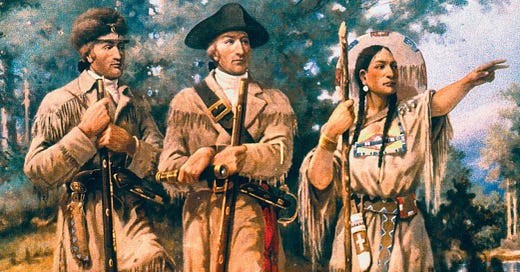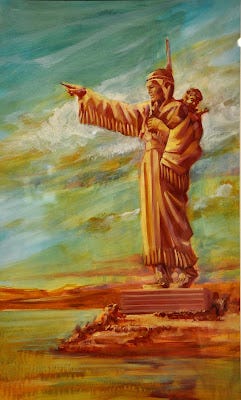Sacagawea was born a Shoshone in 1788 (in the current state of Idaho) and captured from her native tribe during a buffalo hunt at the age of 12 years by the enemy, Hidatsa tribe. There is some dispute over her name’s spelling (also known as Sacajawea) and its meaning. The Hidatsa spelling and translation means “bird woman” and has a hard g but the Shoshone interpretation is “boat launcher” and pronounced with a j sound.
After her kidnapping, Sacagawea was acquired from the Hidatsa tribe through a trade, gambling payoff or purchase by a French-Canadian fur trader named Toussaint Charbonneau. He was residing with the Hidatsa in what is now known as Bismarck, North Dakota. Charbonneau practiced polygamy and subsequently took Sacagawea as his second wife.
The Louisiana Purchase in 1803 included 828,000 square miles of almost completely unexplored territory, nearly doubled the land size of the country and the land required actual boundaries to be established. President Thomas Jefferson hired Meriwether Lewis and William Clark to lead a westward expedition into the new territory to chart the land. They took approximately 40 men and three boards and headed north on the Missouri River. When winter approached, the expedition decided to camp near the Hidatsa village where Sacagawea was residing with Charbonneau. Because of his familiarity with the Native Americans, Charbonneau suggested that Lewis and Clark hire him to be their guide and interpreter along with his wife, Sacagawea who was familiar with the local Shoshones. At the time, Sacagawea was pregnant with their first child. They waited until she gave birth on February 11, 1805 and then at the age of seventeen, with her baby on her back, they began their journey together on April 7, 1805.
Sacagawea was utilized for the Idaho/Montana part of the journey where she had grown up and had knowledge of both the Shoshone and Hidatsa language and culture. She not only served as an interpreter but also provided knowledge on edible vegetation along the way. Sacawagea was a highly skilled food gatherer using sharp sticks to harvest root vegetables and digging up wild artichokes hidden by mice for the winter. Her presence on the expedition sent a message to the Native Americans that this was a peaceful trip. Despite all of her contributions to the journey, payment was only made to her husband. Sacagawea faced all of the same dangers as the men and she had her baby to care for along the way. For his service Charbonneau received 320 acres of land and $500.33
Sacagawea’s bravery and levelheadedness may have saved the expedition when Charbonneau was steering a boat through rough waters and a heavy wind tipped the boat and it began to fill with water. As their invaluable supplies fell into the water and Charbonneau became frozen, Sacagawea calmly rescued their supplies of instruments, books, gunpower, medicine, and clothing from the water. Lewis and Clark named a branch of the Missouri for Sacagawea in gratitude of her rescue work.
Sacagawea returns to Three Forks—an area where three rivers come together in what is now Missouri—where she was captured as a child. Because she recognized her homeland, she was able to better guide Lewis (middle) and Clark on their expedition. PHOTOGRAPHY BY AGEFOTOSTOCK / ALAMY (taken from National Geographic)
While traveling up on the Missouri River in July of 1805, Sacagawea recognized her birth land and on August 15, 1805, the expedition came upon the Shoshone tribe. Lewis and Clark established a meeting with Chief Cameahwait and had Sacagawea serve as the translator. Sacagawea instantly realized the chief was her brother and after an emotional reunion, she continued her interpreting and secured additional guides and horses from the Shoshone for the expedition.
Sacagawea continued with the expedition until it reached the Pacific Ocean on November 15, 1805. Clark’s journal documents the contributions of Sacagawea and the respect he and his men had for her skills. On the return journey, Lewis and Clark split into two groups and Sacagawea traveled with Clark, guiding his group south of the Yellowstone River and through the Rocky Mountains through the Bozeman Pass. The groups reunited on August 12, 1806 and shortly thereafter, arrived back where Sacagawea and her family had started. The expedition survived illness, flash floods, temperature extremes, food shortages, mosquito swarms and more. As a thank you for their help, Clark offered to bring Sacagawea’s son back to St. Louis and raise him as his own with all of his own privileges. Sacagawea and Charbonneau believed their son to be too young at the time but did ultimately take him to live with Clark when he was five years old. Clark provided the Charbonneau family with land to farm in exchange for taking custody of their child. Sacagawea and Charbonneau returned to work for a Missouri Fur Company Trader.
It is believed that Sacagawea later gave birth to a daughter but after that, her life is ambiguous in terms of outcome. Some believed she returned to her native lands until her death in 1884 but most believe she died of typhus in December 1812 at the age of 25. Clark took legal guardianship of both children and raise them as his own.
Cited sources:
History.com Editors. “Sacagawea.” History. 2010 https://www.history.com/topics/native-american-history/sacagawea.
Potter, Teresa, and Mariana Brandman. "Sacagawea." National Women's History Museum. 2021. www.womenshistory.org/education-resources/biographies/sacagawea.
Rizzo, J. (2021, April 20). Sacagawea. History. Retrieved from https://kids.nationalgeographic.com/history/article/sacagawea





